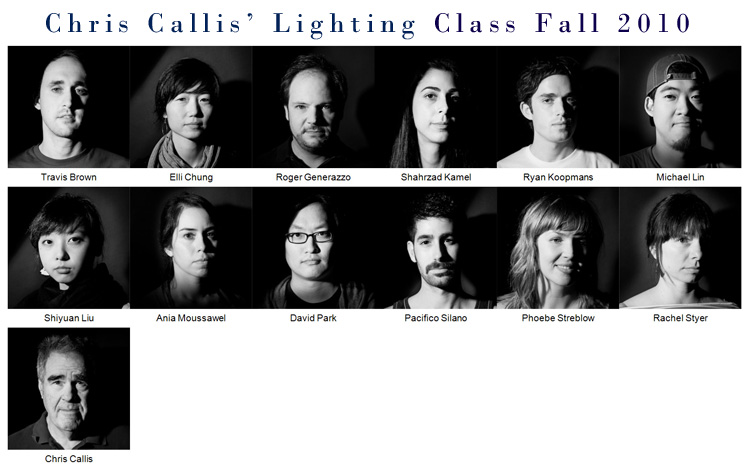1. Make a photograph using flash as a painting tool.
2. Make a photograph using a continuous light source as a painting too.
Plan what you want to achieve with light painting. The lighting scheme should be hard to achieve conventionally.

We learned how to remotely trigger the 5D MII by using a special cable called the Canon N3 to mini phone by connecting the N3 side to the Canon's remote control terminal and the mini side to the Pocket Wizard II's camera port. By setting another Pocket Wizard Plus II to the same channel as the one attached to the camera, the camera shutter can be released by the remote Pocket Wizard Plus II when you press the test button. For light painting with a continuous light source, we set the camera at a long exposure (30 secs) and trip the shutter remotely when ready to start painting. The room has to be dark enough that it doesn't pick up any stray light during the long exposure. The f stop and ISO are determined by trial and error. With practice a rhythm will develop your painting skills.
The set up of the Pocket Wizard Plus II's for light painting using a flash, is an extension of the continuous light setup. This time we put the camera's Pocket Wizard Plus II in the hot shoe of the camera. The cabling remains the same. We need a third Pocket Wizard Plus II to be attached to a Canon 580EXII using a pc to mini cable. The pc end is inserted into the flash's pc terminal and the mini end is plugged into the 3rd Pocket Wizard Plus II's flash terminal. The 3rd Wizard has to be set on a channel that is one number higher than the other two Wizards. The 580EXII is set on manual and the power is set my trial and error. The four factors determining the exposure for each time we flash are subject to flash distance, f-stop, ISO and power setting on the flash. Now we have the 580EXII and 3rd Pocket Wizard Plus II in one hand and the remote camera firing Pocket Wizard Plus II in the other. As we point the flash where we intend the light to land, we push the test button on the 1st Wizard and it trips the shutter and then automatically uses the pocket wizard mounded in the camera's hot shoe to sync with the flash that is set on the next higher numbered channel. The subject needs to remain perfectly still and then as many captures from as many positions of light as needed. In Lightroom, the captures are selected while in Library Mode, right click on one of the selected images, "edit in" and go to bottom of the list to "open as layers in photoshop". Once in photoshop you can use lighten in the blending modes on each layer to have all the lights turned on. Now it is time to make decisions
as to how you work with each of the lights. Have fun and be brilliant.

No comments:
Post a Comment